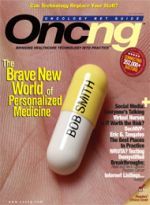DocMVP: Eric G. Tangalos, MD
This month's DocMVP is Eric G. Tangalos, MD.
How do you bring healthcare technology into your practice?
We try never to be infatuated with technologies in search of an application, but instead look for technologic solutions to the clinical problems that we have. Some solutions are very simple; for example, most EMRs have computer screens with refresh rates that make them very difficult to read. The screens are also at eye level, rather than the level at which you read paper charts. For practitioners who wear glasses or are otherwise visually challenged, looking up at a computer screen with a refresh rate that fatigues the eye is particularly difficult. The solution we implemented was to put a printer in every office, giving the physicians the opportunity to share print information (like laboratory results) with patients, and to print documents that they can then use to assemble information, rethink it, and put it back into the electronic record current to the patient’s needs.
What other technologies do you utilize in your daily practice?
We have an electronic portal for reporting of physician practices. We’ve developed a site so that doctors can look at certain preventive services that we think are important, and which the US Public Health Services thinks are important. We currently display nine measures, and each doctor can look at his or her panel of patients and identify those who need immunizations or are outside of a certain reference range. We also have processes in place for the entire group that enable us to target the population that needs a particular preventive service, so that the individual physician doesn’t have to.
The portal also helps physicians with time-limited board certification to demonstrate a practice improvement project every 10 years. The quality data enabled me to take the information we have compiled over the last couple of years and submit it to my board, saying “look at what we’ve done with our immunization, colonoscopy, and mammography rates that are 1) good for patients, and 2) fulfill the requirements that you say are important.” Instead of creating something de novo to accomplish the task, these are ongoing activities with easily retrievable data about my patients and my practice.
What feedback have you received from patients about the portal?
One of the interesting things with quality reporting is that it really causes a practice to change, both for the physicians and patients. For example, if you’re going to target a population that has low mammography rates, you can identify those patients so that no matter when they come in, you can approach them for a mammogram. It takes a while for patients to adjust to such close scrutiny. But doctor and patient both get used to it once they can move beyond just acute care medicine.
Also, we have limits on the range we accept for diabetic control. When you tell a patient “your Hemoglobin A1c is 10.6 and this is not good for you and you’re making me look bad,” it’s amazing how they want to change to make the doctor—patient relationship work. They want to take care of themselves, and now you have this extra piece of information that says “both of us are suffering from you being out of control with your diabetes. I want to help you get back in control, and you can help me be a better doctor at the same time.”
What is the most significant recent development in healthcare technology for practicing physicians?
Electronic records that allow individual members of the healthcare team to work better together. For any office visit, three individuals at a minimum are seeing a patient, and each adds their own information to build the electronic record. Each has a set of criteria they have to follow to accomplish their tasks, and in this way, each provider is able to practice to their maximum licensure. When you’re able to do that, you’re providing the highest level of care in the most efficient and cost-effective way.
What technologies do you foresee having the greatest impact on physicians in the near future?
I still see the Web as being tremendously important. I was able to apply some of the principles I wrote about in the May 2007 MDNG article “Are You Googleable” as I went through my own board recertification in geriatrics. The knowledge-based modules are “open book,” and the most efficient reference source I could find to answer the questions that gave me trouble were Google, and Google Scholar. Google provides a far better search engine than the search engines we traditionally use in medicine. It got right to the data I needed. It is incredibly accurate, robust, and efficient. I think the medical literature search engines have a long way to go to catch up.




